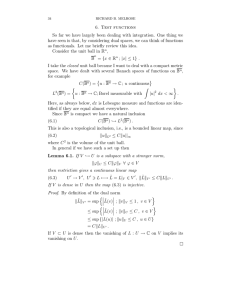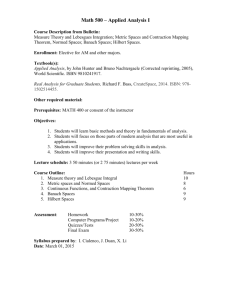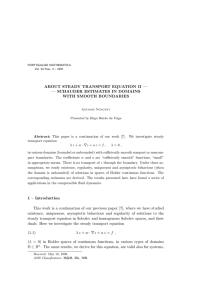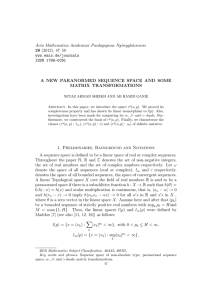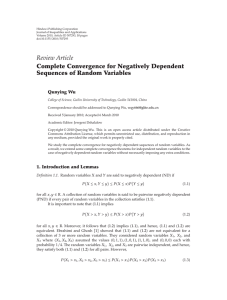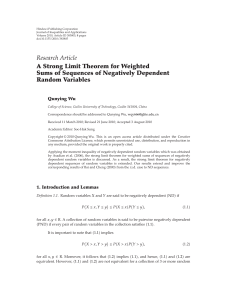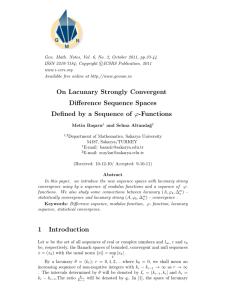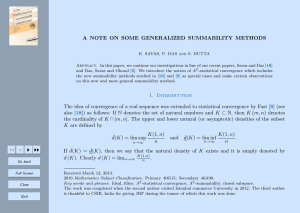Document 10441567
advertisement
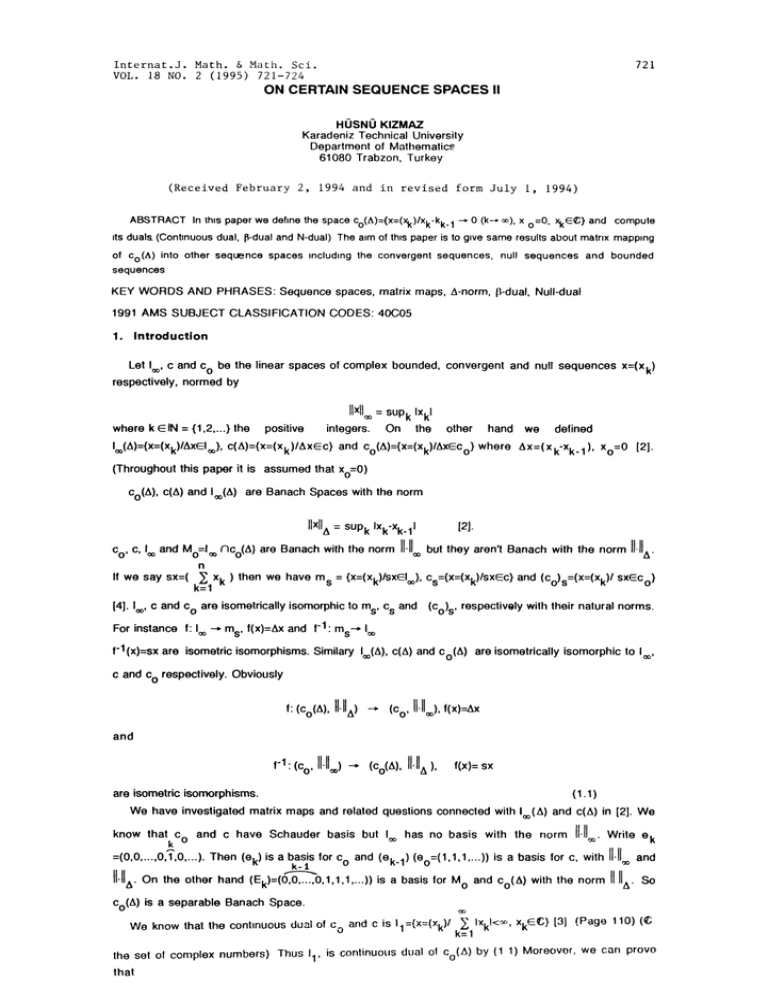
Internat.J. Math. & Math. Sci.
VOL. 18 NO. 2 (1995) 721-724
721
ON CERTAIN SEQUENCE SPACES II
HOSN0 KIZMAZ
Karadeniz Technical University
Department of Mathematics
61080 Trabzon, Turkey
(Received February 2, 1994 and in revised form July i, 1994)
0 (k oo), x o=0, XkEE; and compute
ABSTRACT In th=s paper we define the space Co(A)={x=(xk)/Xk-kk.
duals. (Cont=nuous dual, I-dual and N-dual) The am of th=s paper is to gve same results about mat.x mappmg
of Co(^) into other sequence spaces Includmg the convergent sequences, null sequences and bounded
sequences
=is
KEY WORDS AND PHRASES: Sequence spaces, matrix maps, A-norm, p-dual, Null-dual
1991 AMS SUBJECT CLASSIFICATION CODES" 40C05
1. Introduction
Let Io, c and c o be the linear spaces of complex bounded, convergent and null sequences
respectively, normed by
Ilxlloo
where kEIN
{1,2
}the
positive
Io(&)={x=(xk)/&xElo}, c(&)={x=(xk)/&xEc
(Throughout this paper it is assumed that
the
hand we
other
Co(&)={x=(xk)/&xECo}
Xo=0)
and
where
delined
&x=(xk-Xk.1), Xo=0
[2].
Banach with the norm
I1-11,
are Banach Spaces with the norm
Co(A), c(&) and I=(&)
Ilxll&
co, c,
suPk IXkl
On
integers.
x=(xk)
[2].
suPk IXk-Xk.ll
Io and Mo=lo ClCo(&) are Banach with the norm I1.11
b,
,,,,y ,,,,’,
n
If we say sx=(
klXk=
then we have m
s
{x=(xk)/SxEl=}, Cs={X=(Xk)/SXEC
and
(Co)s={X=(Xk)/sXECo}
I=, c and c o are isometrically isomorphic to ms, cs and (Co)s, respectively with their natural norms.
For instance f" I= ms, f(x)=&x and f-1. ms
f’l(x)=sx are isometric isomorphisms. Simila I(), c() and Co(&) are isometrically isomorphic to I,
[4].
c and co respectively. Obviously
,: (Co(^),
II.II,)
(c o,
II.II=), ,(x)x
and
r.(,=o, II.II=)
%(,),
II.II, ),
,(:,()= x
are isometric isomorphisms.
We have investigated matrix maps and related questions connected with
know that c O and c have Schauder basis but
=(0,0
0,’’,0
I1.11,. On
). Then (e k) is a basis for c o and
h,, ohr hand
(Ek)=(0,0,...,’"--"O,1,1,1
Io
(1.1)
Ioo(4
and c(&) in [2]. We
has no basis with the norm
(ek.1)(eo=(1,1,1
I1.11
)) is a basis for c, with
)) is a basis for M o and
Co(&
with the norm
Write e k
I1.11
and
I1. so
Co(&) is a separable Banach Space.
We know that the conhnuous dual of c o and c is
the set of complex numbers) Thus
that
11,
Ii={x=(xk)/k’.lIkl<x,,= XkEt
is continuous dual el
Co(A) by (1
[3] (Page 110) (
1) Moreover, we can prove
H. KIZMAZ
722
’=Mo= Co(A)
w,h h,,
norm
I1-1!, ,. wh,,,e h,, bar denotes closure. For this, let xECo(&) and ::>o be any number
Then
k
there exisls one and only one
y=(yk)(ECo
such that
Xk=
ly
(1.1) and a corresponding index
i=
M=M()(E IN such that ly kl</2 for all kzM. Now we lake
Xk’
Zk--
XM. k>M
thus
2.
z=(zk)E;cC Co(&
belongs to the open ball B(x.:) which s in
(Co(&),
II.I1,)
I-dual, N-dual and Matrix Maps
If X is a sequence space, we define
X={a=(ak)l klakXk= is Convergent for each xEX}
xN={a=(ak)/lin akXk=0, for each X}. X is called the ll-(or generalized KSthe-Toplitz) dual [1] and
we will say that X N is N-(or null) dual space of X. We have that if XCY. then YICXI. The N-dual has
similar propedies with the -dual. For inslance if XCY than yNcxN and XX N
Obviously
,I N- N
N
cN=c’
=- Mo
Co
cNI&) Ioo(&) {a=(ak)/lkakCo}. Let (X,Y) denote the set of all infinite matrices A=(ank
which map X
into Y.
LEMMA 1. Let
(ak)(EI
Proof. It is lrivial if
and if
x=(xk)
limklakXkl=L exists for an xECo(A ), than L=0.
_--
is bounded. Suppose that
Then x can’t have a bounded subbequence. II
we can take
X’k,0 for all rEIN.
Now let =-), than there exists an
L
get
> 1. for all k-zM and
lakl
-iXkl
take max {M
LEMMA 2.
Proof.
-
MI=MI()E IN such lhal <lakXkl<
<oo
-,, 0 (k
oo) [2]. Let 1, then we have
,M2}=M then
k
Ix k
<1 and >
for all kzM 1. Thus we
(2.1)
lor all
Xkl
=1
=oo. This contradicts with (2.1).
z
IXkl
k
limklakXkl=L>0.
(Xkn) is bounded then limnlaknXknl=0 implies L=0. So
kl= IXkl
x
We have that k
is unbounded and
xE.:Co(&
k>M2(1)IN.
If we
So L must be zero.
IXkl
coN(A)={a=(ak)/(kak)Eloo}=E.
Suppose that
xk
a=(ak)E E.
Since lim k
xk
--=0
for all
x=(xk)ECo(A
[2], Ihen we get
limkakXk=limkka k --=0. This implies that aE;coN(&).
Now let a@coN(&). Then limkakXk=0 for all xE;Co(& ), then lhere exists one and only one
y=(yk),:co,
CERTAIN SEQUENCE SPACES
723
n
such that x
n- k’,k
(1_
limnanXn
hmn
1)
n
k=lanYk=O
for all
ank=j
klankYk=O,= for all XCo.
get lim n
Sup n
I=
kllank
sup n
if we take
y=(yk)C
an
lsksn
O,
k>n
Then
I=
kllan
Sup n
A=(ank C(Co,Co) and we have
nlanl <
For the next results we ntroduce the sequence
R=(Rnk)=
[4]
Ths completes the proof
(Rk) [resp
malnx R] gven by
Rk= i--’a
[resp malnx
i-- ani )]"
LEMMA 3.
Co(A‘)={a=(ak)CI1/(Rk)El coN(A)}=D
(3
Proof. Suppose that aED If
XCo(A‘
then we use Abel’s summation formula to get
n
n
k__lakXk
n
k
kl(ilal) (Xk-Xk+ 1) + (k__lak) Xn+
n
kl(Rl=
Rk+l) (Xk Xk+l) + (R1 Rn+l) Xn+l
n+l
Rk(Xk’Xk-1)-Rn+l Xn+l
(2 2)
k=l
This implies that
If
aco(A‘
exists
__klakXk is convergent, lhen a@cPo(A‘).
then
k=l
akx k is
y=(yk)ECo such that x k
n
XCo(A‘
Obviously al
If
XCo(A‘ ),
then there
i=lYi (1"
Then
n
convergent for all
k
n
klRkyk= =kl(= i=1 yi) ak+ Rn+I klyk
n
with Abel summation formula Thus we have
n
n
2
k-1 akXk=kl(Rk’Rn+l)Yk
If we take
n
=k= (i-- ai)yk
(2.3)
n
a
1(: k(:
n
ank
0
k>n
n
then
A=(ank) (Co,C) since limn
k=l
ank Yk limn
lank= Yk
exists for all
c o (2 3).
This implies that
724
H. KIZMAZ
n
n
SuPn k= lank =SuPn k= li=,ail <
[4]. Thus we get
k=l
IRkl < oo. Furthermore (2.2) implies that lira n
Rn+l xn+l exists for each XECo(&) then we get (R n)ECoN(A) by lemma 1. This completes the prool.
THEOREM
1.
A=(ank) E(Co(A),c
iff
(Rnk)EcNo(A), for each nEIN
T
T2. R= (Rnk)
Proof. If
XECo(A
EE(Co,C
aE(Co(A),c
then the series
this implies that
An(X
SuPn k=l lankl <=
166). From lemma 3 we have
k
1=
klankxk=
and lim n
are convergent for each nEIN and for all
kank=
IRnkl<=, lim k Rnk Xk=0
ap exists for each pEIN
for each nlN and for all
[3] (page
xElCo(A). This
proves T 1. If we write again (2.2) we get
m
m+l
kY’lank= klRnk= (Xk’Xk-1)’Rn
Xk
m+
Xm+
(2.4)
and
A n (x)=
x
(x Xk.1
klank
klRnk
we use again
(2.5) we get
k
(2.5)
k
lemma 3 and
This shows that RE(Co,C ). If
Similarly we can prove that
the sufficiency o! T and T2.
AEE(Co(A),Co) iff T and REE(c o,Co)
ii) AEE(Co(A), I=) iff T and
iii) AEE(Co(A), Mo) iff T RE(I=, I=) and
i)
B=(bnk)=(ank an k+l E(Co(A),co)
iv) AE(Co(A), Co(A))iff (ank) EClo(A), for each nlN and C=(Cnk)=(ank-an.l.k)E(Co(&),Co) (aok=O)
Open questions
1) Matrix maps for M o.
2) Mo has a Schauder basis with
Then (Mo,
I1.11. , s <Ek). <w, can
write x=
I1.11 ) s separable.
Is MO separable or have a Schauder basis with
-=
kl(Xk
Xk.1) E k, each
xEM o
I1.11(R)
3) I! is obvious that co C c C Mo C
and inclusions are strict. In this order, is lhere a separable
space E which is cC EC
with the norm
not, is c an upper bound according to separability?
I=
I=
I1.11(R) ,
(x-and J]-duality of
sequence spaces, Proc____. Comb. Phi.__J s__0_.. 1967
REFERENCES
[1] Garling D.J.H., The
63(963-981
[2] KIzmaz H., On Certain Sequence Spaces, Canad. Math. _Bull. 25(2) 1981 (169-176)
[3] Maddox I.J., Element of Functional Analysis Cambridge 1970
[4] Stieglitz M. -Tietz H.,
Malrixtransformationen Von
Ergebnis0bersicht Math. Z. 154 (1977) (1-16)
Fongenraumen
Eine



